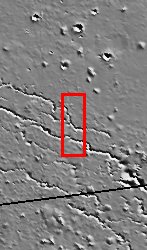
About 1000 km west of the massive Elysium volcanic complex, a system of branching troughs shows a continuum of features that provides clues to their origin. Within the scene there are fully formed troughs, some approaching 2 km in depth, as well as shallow, discontinuous pits and troughs. The presence of the latter landforms suggests that a process of collapse is responsible for producing the deep and continuous final form of the troughs.
Note: this THEMIS visual image has not been radiometrically nor geometrically calibrated for this preliminary release. An empirical correction has been performed to remove instrumental effects. A linear shift has been applied in the cross-track and down-track direction to approximate spacecraft and planetary motion. Fully calibrated and geometrically projected images will be released through the Planetary Data System in accordance with Project policies at a later time.
NASA's Jet Propulsion Laboratory manages the 2001 Mars Odyssey mission for NASA's Office of Space Science, Washington, D.C. The Thermal Emission Imaging System (THEMIS) was developed by Arizona State University, Tempe, in collaboration with Raytheon Santa Barbara Remote Sensing. The THEMIS investigation is led by Dr. Philip Christensen at Arizona State University. Lockheed Martin Astronautics, Denver, is the prime contractor for the Odyssey project, and developed and built the orbiter. Mission operations are conducted jointly from Lockheed Martin and from JPL, a division of the California Institute of Technology in Pasadena.
Image information: VIS instrument. Latitude 21.1, Longitude 123.3 East (236.7 West). 19 meter/pixel resolution.

